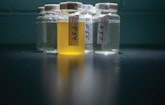
Charlie Martin, city engineer, in front of the City of Graceville Advanced Wastewater Treatment Facility’s sequencing batch reactor.
Charlie Martin always loved science and solving problems. That makes him a perfect fit in the clean-water profession.
As city engineer in Graceville, Florida, he’s in charge of the wastewater treatment plant, the drinking water system and the city’s National Environmental Accreditation System (NELAC) certified laboratory, which tests samples from three counties in Florida and one in Alabama.
He’s also active in training, for his own operations team and as an instructor at the University of Florida TREEO Center, based in Gainesville. While working in what he calls a “sleepy town” of about 2,000 in Florida’s panhandle, he looks beyond the day-to-day in efforts to improve his plant and perhaps contribute to the industry’s body of knowledge.
“Research in the water and wastewater industry — that’s my passion,” says Martin, who holds Class A (highest) wastewater operator and Class A water operator licenses. “It’s about finding novel approaches to problems that are going to continue as we live on this planet. Whether it’s nutrients or emerging contaminants that are coming out on the water side and that ultimately end up in the wastewater, how do we deal with that?
“Could we use wastewater microbes to reduce those contaminants? Sometimes we just look at those things from a chemical standpoint, but bacteria may help us deal with the problem. We may have to marry bacteria with our traditional water treatment techniques. I hope to get into novel approaches to treat environmental and water challenges that are emerging in our society.”
Martin won a 2019 William D. Hatfield Award from the Florida Water Environment Association. He previously received the regional 2017 Thomas P. Smith Award for excellence and leadership from the association’s Big Bend Chapter and the 2018 statewide Leroy H. Scott Award for performance and professionalism.
DESIRE FOR LEARNING
A Miami native, Martin earned an associate degree in chemistry from Miami-Dade Community College in 1991. Soon after he graduated, a fellow church member, who worked for the city of North Miami and knew Martin’s background, suggested he consider a career in water treatment. Before long, Martin had a job at the city’s lime softening plant.
About a year later, he moved to Graceville, about an hour west of Tallahassee and home to The Baptist College of Florida. There he went to work as a lab technician, helping with the startup of the city’s environmental and water lab. While there, he earned a bachelor’s degree in biology and advanced physical science from Troy University.
Martin has been there ever since, apart from a year as a vocational instructor at nearby Jackson Correctional Institution and a year teaching sciences for the Graceville school district. Along the way, he earned water and wastewater operator certifications.
In 2007, city leaders encouraged him to pursue an engineering degree. He took the prerequisite courses at the Florida State campus in Panama City and then transferred to the Florida A&M University - Florida State University to study for a master’s degree in civil engineering.
“While I was there, I was offered a scholarship to get my doctorate,” he recalls. “I talked to my boss about it, and he said I would be crazy not to take advantage of that.” In 2015 he received his Ph.D. in civil engineering. He earned those degrees while still working at Graceville.
SOURCE OF INSPIRATION
College studies helped ignite Martin’s passion to innovate. At first, he did research on a strain of E. coli bacteria to which a firefly gene had been inserted — the cells fluoresced in the presence of toluene. “I tried to get it to fluoresce with nitrobenzene, which is a contaminant that comes out of wastewater treatment plants,” he says. “I was trying to show that you could use those genetically engineered bacterial cells so that when they came in contact with a contaminant, they would light up like a firefly. I could never really get that to work.”
Instead, he looked closer to home to investigate simultaneous nitrification-denitrification, or SND, in Graceville’s sequencing batch reactor. He wrote his doctoral dissertation on how his plant could meet its permit using SND combined with traditional nutrient reduction.
Graceville’s SBR (Aqua-Aerobic Systems) serves the city, along with the 2,000-bed Graceville Correctional Facility. Its design flow is 1.1 mgd; the average flow is 0.71, although during rainstorms, inflow and infiltration can drive daily flows to 1.2 mgd or higher. Each year, the plant teams does some sewer system rehabilitation with cured-in-place pipe lining, manhole lining and pipe replacement.
Wastewater passes through a bar screen and PISTA grit system (both Smith & Loveless) before entering the SBR. Effluent is disinfected with chlorine gas before discharge to Holmes Creek. The plant consistently meets its permit limits of 5 mg/L BOD and TSS, 3 mg/L total nitrogen and 1 mg/L phosphorus.
Biosolids are treated in the Aquaconeer P-Uptake Digester Process, which is designed to limit effluent phosphorous without chemical treatment while significantly reducing aerobic digester power costs. “It includes an anaerobic period to allow bacteria and alkalinity to reduce the phosphorus level, so the decant won’t have any impact on the treatment system,” Martin says. “The phosphorus level in the decant coming back to the headworks is 2.5 mg/L.” Biosolids are landfilled after dewatering on a screw press (FKC) and drying beds.
A NOVEL APPROACH
An observation about Graceville’s SBR led Martin to investigate SND. In traditional nitrification-denitrification, bacteria convert ammonia to nitrite, then to nitrate and finally to nitrogen gas, which bubbles to the surface and escapes. Typically, the steps occur in separate anoxic and aerobic tanks or in separate zones in a single tank. In SND, ammonia is converted directly to nitrite and then to nitrogen gas in a single tank; the process requires less oxygen and treatment time.
In 2008, Martin observed that the plant was delivering effluent that was low in nitrogen and phosphorus, despite never having an anoxic phase. “The next spring when we started watering the lawn, we noticed air bubbles coming up from where the air lines were running, and we realized that we had been losing air. We fixed it by putting couplings at the joints.”
During college studies in 2014, he recalled that event and did a literature review in which he determined that SND had been occurring in the plant: “When the air lines were leaking, we were getting just enough air to keep the system anoxic. The way SND works is you are using nitrifying organisms that are able to nitrify under anoxic conditions. So as they nitrify, they are generating nitrite. Then the facultative bacteria on the edge of the floc use that nitrite instead of oxygen in order to break down CBOD.” That process yields nitrogen gas.
He wants to explore adding variable-frequency drives to the Graceville plant’s positive displacement blowers so that instead of operating all-out, they can be dialed down: “If we could control how much air is being put into the SBR, then we could keep it in an anoxic condition longer and promote SND.”
EXPERT TRAINER
To keep his team sharp, Martin is a big believer in training. The plant operations team includes:
William Austin, 17 years of service, Class B wastewater and Class C drinking water licenses
Michael Canaday, 14 years, Class C wastewater and Class C drinking water
George Chestnut, six years, Class B wastewater and Class B drinking water
James Jefferson, operator trainee
“I try to get people who enjoy doing different things and are not afraid to learn,” Martin says. “We encourage our people to get additional certifications, and the city gives them raises for that. I also try to make sure they are being constantly stimulated.” Team members attend classes offered by TREEO Center and the Florida Rural Water Association.
Among Martin’s mentors in the profession is Ron Trygar, senior training specialist at TREEO Center, who has known him since 1997. In 2005, as a region director for the Florida Water and Pollution Control Operators Association, Trygar enlisted Martin’s help to provide chlorination and disinfection training sessions across the Florida panhandle.
After joining TREEO Center in 2006, he worked with Martin to build drinking water and wastewater exam preparatory classes that are still in high demand. “Around the same time, I encouraged the Florida Operator Exam Committee director to include Charlie on the drinking water and wastewater exam committees,” Trygar says.
“Charlie has helped TREEO Center deliver quality training to operators in both water and wastewater treatment. He has traveled out of state to deliver contract courses for us and has provided exam preparation tutoring to operators on his own time. We continue to collaborate on projects and treatment plant troubleshooting. Charlie is a wonderful trainer; he has a way of making the learning fun and easy to follow. Many students come into our classes hoping to see Charlie as one of the instructors.”
MAKING A DIFFERENCE
Training is another facet of a career Martin quickly grew to love: “The biggest thing I love about it is that I know I’m serving the community, protecting the environment and protecting public health. I’m a science buff, and this field is basically applied science — using science to solve problems. You can never get comfortable because as soon as you think you have it figured out, there is always something new to learn.
“All operators know we are greatly needed. Although we may be sometimes unappreciated, we can never lose sight of the value of what we do.”









